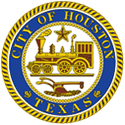Houston Fire Department
HFD History
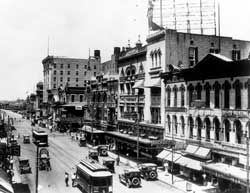
History is not just the chronicling of both major and minor events of lives or organizations. It's the basis and the lifeblood for tradition to be carried on by eachsucceeding generation.
It all began in 1836 just after the Allen Brothers landed at what is now known as Morgan's Point. The brothers, being great land speculators, made their way up a body of water whose banks were dotted and decorated with the greatest land animal-the buffalo. That was the humble beginning of what is now known to all of us as Buffalo Bayou. Augustus Chapman Allen and John Kirby Allen knew that there was greatness in the land on which they were standing. They purchased a portion of the John Austin survey from a Mrs. Parrott and began platting it. On a particular night Augustus Allen and Mrs. Allen were having General Sam Houston as their guest for dinner. Jokingly, Mrs. Allen asked Augustus what he intended to name his little town. Augustus replied, "We'll name it Houston in honor of our distinguished guest".
For a detailed history of the Houston Fire Department, please visit the official home to HFD's history, The Houston Fire Museum. www.houstonfiremuseum.org
Also see, the History of the Fire Chiefs of the Houston Fire Department >>>
 By 1837 there were so many people in the little town of Houston that fires had become more frequent, log houses were replacing the tents, and the original plat of Houston embraced 62 blocks. By the close of 1837 there were over 1,000 people within the little town. Augustus Allen organized a bucket brigade, named it "Protection #1" and applied for a charter in 1838. Protection #1's motto was "Simper Fidelis". One of the first pieces of equipment was a large barrel with holes drilled on either side with a rod and two wheels placed on it with handles attached to the rod ("axle") so that the men of the town could pull it. This barrel also had buckets attached with hooks at the top. By the end of 1847, Houston had cisterns and it's first homemade fire engine which consisted of a big wooden box with wheels on it and a pump and a hole attached to the bottom of the pump which would suck water out of the cistern into the box where the water would be pumped into the exit hose leading to the fire. This original homemade fire truck was stationed on what we know as Market Square. (Station #1 had been housed in five different locations: Fannin and Capital 1895, Prairie and San Jacinto in 1895, Texas and San Jacinto in 1904, Preston and Caroline in 1924, Preston and Bagby in 1968, closed in 2001.)
By 1837 there were so many people in the little town of Houston that fires had become more frequent, log houses were replacing the tents, and the original plat of Houston embraced 62 blocks. By the close of 1837 there were over 1,000 people within the little town. Augustus Allen organized a bucket brigade, named it "Protection #1" and applied for a charter in 1838. Protection #1's motto was "Simper Fidelis". One of the first pieces of equipment was a large barrel with holes drilled on either side with a rod and two wheels placed on it with handles attached to the rod ("axle") so that the men of the town could pull it. This barrel also had buckets attached with hooks at the top. By the end of 1847, Houston had cisterns and it's first homemade fire engine which consisted of a big wooden box with wheels on it and a pump and a hole attached to the bottom of the pump which would suck water out of the cistern into the box where the water would be pumped into the exit hose leading to the fire. This original homemade fire truck was stationed on what we know as Market Square. (Station #1 had been housed in five different locations: Fannin and Capital 1895, Prairie and San Jacinto in 1895, Texas and San Jacinto in 1904, Preston and Caroline in 1924, Preston and Bagby in 1968, closed in 2001.)
In 1852 Liberty Fire Company #2 was organized. Liberty #2's first engine was a hand engine which was purchased in Boston, MA. At that time it cost $2,000! The first Hook and Ladder Company #1 was organized in 1858. It too was a homemade truck. Liberty #2 had the first steam engine in 1856. (Station 2 was located at Sampson and Preston in 1910, Bagby and Capital in 1926, West Dallas and Bailey in 1965 (closed in 1986-reopened at Woodway and Chimney Rock in 1992). In 1926, Station 2 became Station 17.
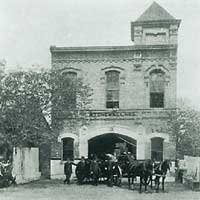
Stonewall #3 was organized in 1867 and was located on Travis St. where the Rice Hotel backside sits today. Later it moved to its own building on Preston between Smith and Louisiana. The motto of Stonewall #3 was "Trust in Us". (Station #3 was at Preston & Smith in 1895, Houston Ave and Spring in 1903, Crocket and Colorado in 1937, and West Alabama and Cummings in 1958 to present.) Station 3 was remodeled in 2003.
Fire Station #4 was located in the Second Ward and was organized in 1872. (Station #4 in 1911 was at Berry and Louisiana, Shepherd and Banks in 1941, was closed in 1979 and reopened at West Little York and Bingle in 1986.) In 1979, Engine 4 was relocated at new station 16.
The city by now had been divided in six wards with very distinct boundary lines.
Brooks #5 was located in the Fifth Ward and was organized in 1874. It was located at Liberty and McKee Streets. Brooks #5 was the first station in which the men fixed crock jugs loaded with chemicals and put them on a home made wagon. They became known as the "soda fountain" station. (Station #5 was at Hardy and Nance in 1895, rebuilt on the same location in 1932 and relocated to Hollister and Hammerly in 1977.) This station underwent much needed renovations and was temporally closed in 2009. The station went back into service in June 2010.
Mechanic #6 company was organized in 1873 and was located at the juncture of Washington and Preston Streets which is now just east of the central post office. The fire station actually sat on what is known as Bagby Street today. Mechanic #6 was made up of men who were just that-mechanics. They were known for two things: they loved to fight fire but they also loved to have fistfights, especially with the men from Stonewall #3. This competition produced a tradition of skullduggery, which lasts right on into the millennium of today. (Mechanic #6 was located at the intersections of Washington and Preston 1895, 1903 at Washington and Ash Place, 1931 at Henderson and Decatur, and in 1987 relocated at Washington and Lakin.) 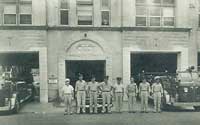
Young America #7 was opened in 1878. After a few months the name was changed to Eagle #7 and its home was located at the foot of Congress near Main Street. (Station #7 was located at Milam and McIlhenny in 1899 then moved to Elgin and Austin in 1969.)
Washington #8 was organized and located at the corner of Crawford and Polk where it is still located today. (Note: A 107-year tradition of the fire station being located on this corner will end in 2001 with the building of the new sports arena.) Washington #8 had the distinction of having a Clapp & Jones Steamer (state of the art for that period). (It was located in 1895 at Polk and Crawford, Polk and Crawford again in 1958, Polk and Crawford again in 1970 and will be closed in 2001.) Stations 1 and 8 were combined and relocated to the corner of Milam and St. Joseph and Station 8 was reopened in June of 2001. A new Station 8 broke ground in 2006 at 1919 Louisiana at the site of the Old Borden Ice Cream plant. This new "super station" went into service on April 21, 2008.
Curtain #9 was organized in 1881. This station eventually found a home on Keene St. just off Hogan. (Curtain #9 at Keene and Hogan in 1899, Hogan and Freeman in 1908 rebuilt at Hogan and Freeman in 1970 to present.)
Seibert #10 went into service in 1894 located at 205 Chartres at Franklin. Its first piece of equipment was a hose wagon pulled by three beautiful horses. (Station #10 remained from 1895 until 1985 at Chartres and Franklin when it was closed and reopened at Corporate and Clarewood in 1985.) In 2003 the land at 205 Chartress was sold by the Mayor Brown Administration and old Station 10 was razed. This land had been associated with the Houston Fire Department for 109 years.
In 1895 the city had grown so much and the demand was so great that the department became paid, thus ending volunteerism from 1838 to 1895. However, volunteerism within the Houston Fire Department was reinstated in December of 1941 shortly after President Roosevelt declared war, and continues to exist today with 20 men who are still carrying on the rich tradition built into the Houston Fire Department.
In 1904 Brunner Fire Company was established at the corner of Washington and Fowler. In 1913 the City of Houston annexed this volunteer company and it became Station #11. Prior to 1913, there was a chemical engine 11 and it was housed at 307 Smith St. The old wooden clapboard station at 4511 Washington at Fowler was torn down and a new modern stucco and concrete station was built in 1937 and remained in service at the same corner until it was moved to T. J. Jester and Larkin in the early 90's. Station 11 was closed for a while in the 1990's and the crew was relocated to Station 2 at Woodway and Bering. (Station #11 was constructed in 1915 and remained in service at the same corner until 1995 when it was moved to T. C. Jester and Larkin.)
By 1904 the Houston Fire Department had 129 men and 11 stations with 797 fires for the year and a maintenance cost of $165,577.15. (Note: The largest fire that the Houston Fire Department had faced in its young history occurred on Feb. 21, 1912.) The largest fire started at Hardy and Logan and burned all the way to Liberty Road burning up several steam hose wagons.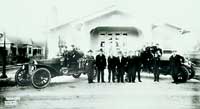
Fire Station #12 was opened up in 1916 at Sumpter and West. (Station #12 was located at Sumpter and West from 1916 until 1958 when it was relocated at Alber and Terry.)
Station #13 went into service at 428 West 18 th in 1918 and was relocated in 1956 to West 43 rd and T. C. Jester.
Old Station #2 at 319 Sampson was changed and renumbered to become Station #17 in 1928. The original building that served as the Heights City Hall was erected in 1914 and when it was annexed in 1918 it became Station #14 and was located at Yale and 12 th Streets. It served as Station #14 from 1918 to 1987 when it was closed. (It currently serves as a historical landmark and has been restored to its original multi-service facility as it was in 1914.)
Station #15 was originally located at Preston and Hooker Sts. Station 15 was relocated from the central part of downtown out to Houston Avenue and North Main in 1918. In 1947 it was relocated once again to 402 Tabor and North Main, and recently moved into its new quarters at 5306 North Main and Dunbar in 1999.
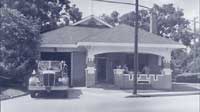
Station #16 was added at Westheimer and Youpon. (Station #16 was built in 1928 and they were relocated to Richmond and Dunlavy in 1979.)
Firehouse #17 took over the quarters of old Station #2 on Sampson and York in 1926 and served out of that station until 1983 when they moved into their new quarters at Navigation and Delano.
Early records reflect that in 1905 Steamer 18 ran out of Station 10 at 205 Chartress along with Hose Wagon 10. Station #18 went into service in 1925 at the corner of the 4400 block of Walker in a tent while its new station was being built at 619 Telephone Road and was occupied on July 7, 1926. In 1976 Station #18 moved into old #24's station after it was closed while their new station was being constructed at their Telephone Rd. location. They moved back into their station on Telephone Rd. in 1980.
Station #19 was built at the corner Greg and New Orleans in 1925 (the new quarters are located at the opposite side of the intersection and was built in 1979).
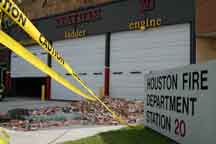
Station #20 was annexed into the fire department in 1926 at the corner of Avenue F and 73 rd in the old "Magnolia Park" township, and a new Station #20 was located in 1973 at Navigation and Marcario Garcia. This Station was severally damaged by Hurricane Ike in 2008 and reopened in December 2009.
Houston's first fireboat was purchased in 1926 at a cost of $320,000 and was located at the foot of Manchester St. These quarters were manned at that time by members of the Houston Fire Department and were given the number 21 for their quarters. It was more commonly known as the Fireboat Station and remained numbered 21 from 1926 to 1972. During that time the original boat was moved to other quarters and the Captain Cortty was bought in 1950 and put in 21's quarters. During the later part of this time span, the Port Authority took over the manning of the fireboats. In 1972 a new station was built located at So. Main and O'Meara for Firehouse #21.
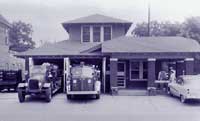
Firehouse #22 was built in 1926 at Harrisburg and 78 th Streets and was torn down in 1969 to make way for the new station at Harrisburg and 78 th. This same building serves as the Hazmat station and has done so since 1987.
Firehouse #23 was located in the old Manchester section at San Antonio and Manchester in 1927. In 1976 it was moved about eight blocks away to Lawndale and Medina.
Firehouse #24 was built in 1928 at the corner of Palmer and Bell just east of downtown and was closed in 1977. A new station 24 broke ground in 2008 and went into service at 2625 Reed Rd, just west of HWY 288 on October 26, 2009. The new station was funded by a Community Development Block Grant and the Fire Consolidated Construction Fund. It is little over 11 thousand square feet and has three bays.
Firehouse #25 was built in 1928 at Blodget and Velasco and was relocated in 1979 to Scott and Rosewood. In 2003, as Class #7 is about to start, Station 25 is preparing for its 75 th year in service in the 3 rd Ward Area. Station 25, in 2003 (B Shift) transformed the bay doors to look like a New York fire station by painting the doors red with black and gold numbers. They also have the only 8 ft by 6 ft. logo mounted within the station.
Firehouse #26 was the old Garden Villas Fire Station located at Broadway and Park Place and was built in 1930. New Station #26 is currently located at Dixie and Chaffin and started in 1953.
Firehouse #27 was already on the drawing board when WW II broke out and was completed at the corner of Lyons and Kress Sts. in 1941 in the Denver Harbor addition of Houston, Texas. A new firehouse 27 is currently being built at Lyons & Gazin Street scheduled for opening in late 2004.
Firehouse #28 has the distinction of having had three firehouses. It was originally in old #4's station at Berry and Louisiana in 1941 and was relocated to the outskirts of Houston in 1953 at the corner of Westheimer and Sage. It was relocated to Chimney Rock and Dolores in 1987.
Firehouse #29 was also a city hall/fire station originally built for the East End Volunteer Fire Department in 1945. It was located at Barkley and Winkler and was annexed in 1948 when it became Firehouse #29. It was relocated at Galveston Rd and Ahrens in 1977. It was originally a single engine company and in 1977 it became an engine, ladder, and ambulance company. There is also an ambulance supervisor now running out of Station #29.
Firehouse #30 was originally the Lindale Volunteer Fire station and was annexed in 1949 at King and Helmers. It was relocated at Irvington and Frisco Sts. in 1977. It too was a single house and now has an engine, ambulance, an ambulance supervisor and a cascade truck.
Firehouse #31 was the original Whitney Place Volunteer Fire Station at Crosstimbers and Oxford and was annexed in 1950. It was relocated in 1982 to West Crosstimers and Old Yale. Station 31 was renovated in 2003.
Firehouse #32 was the original Garden Oaks Volunteer Fire Station located at the corner of West 34 th and Brinkman and was relocated in 1980 at Tidwell and Mayberry.
Firehouse #33 was relocated to a new building just down the street from the original station in 2004. The old station held the unique distinction of being one of the last stations to be housed in an original volunteer station-it being the city hall/fire station of the Brasewood section of Houston at the corner of Fannin and Brasewood and was annexed in 1950. The City sold the old station in 2006.
Station #42 was located in the all black section of Clinton Park and was also an original city hall/volunteer fire station and was annexed in 1955. It was relocated at Clinton and Mississippi in 1980.
Station #45 was also part of the same annexation as was Station #44. It was located at the corner of Banner and Manitou in 1956 (O.S.T. Acres V.F.D.). In 1985 a new station was built at the corner of North McCardy and W Old Spanish Drive.
Also in 1956 as part of this large annexation Station #46 was opened replacing the old Sunnyside VFD at the corner of Corinth and Stassen. In 1976 a new station was built at the corner of Corder and Scott. Station 45 was remodeled and reopened in late 1999.
Station #47, being a part of this annexation program, went into service in the old Alameda Plaza Community Hall/Fire Station at the corner of Doris and Lydia. In 1960 the city built a new fire station for the citizens of Alameda Plaza at Tidewater and Alameda.
Station #53 was originally Station #43 and took its place in 1956. It received a complete facelift in 1999 and reopened in April of 2000 at the same corner of Uvalde and Vicksburg.
Fire Station #34 when built in 1952 was one of the most modern stations standing in all of Houston and was located at the corner of Berry and Schuler. It was closed and relocated at Laura Koppe and Arkansas in 1987.
Station #35 holds the distinction of having had to give way to road progress as it was built originally at Holmes Rd. and South Park in 1953, which later became the South Loop. It currently stands at VanFleet and St. Lo and was built in 1965. Station 35 was remodeled in 2003 with its reopening in June, 2003.
Station #36 also holds the only honor of being able to be seen but not located on a specific piece of land. This has been commonly known as the Hobby Airport Station. In 1956 it was nothing but almost a mere barn located on the west side of the Hobby Airport. In 1957 the units were moved to a more stabilized building and then in 1985 it was moved to its present location at Airport and Dover, all within sight of each other at Hobby Airport. Station #36 took the place of the old Garden Villas Volunteer Fire Department.
Station #37 has been the most tucked away station within the Houston Fire Department as it has been located in the quiet residential area at Aberdine and Stella Link since 1955. The land for this station was donated by the developer of this Brasewood subdivision. A new Fire Station 37 went into service in September 2009 at 7026 Stella Link. It is a three-bay station and features award-winning architecture and construction.
Station #38 was built in 1955 to begin servicing the Spring Branch area. It's located at Silber and Hartland.
Station #39 in 1955 was built on a barren wasteland at Pickfair and Kelley Sts. One could stand at the back door of this new station and look east as far as he could see. This station, shortly after opening, was marred with a tragedy of three good firefights being severely burned at an oil pit fire.
Station #40 was located at the corner of Old Spanish Trail and Black St. in 1957. It was originally a ladder company and an engine company. Today it is an engine and ambulance company and was refurbished and reopened in June of 2001.
Station #41 was built in the industrial section east of downtown in 1955 at the corner of Pearl and Amarillo.
Station #43 was also a volunteer station belonging to the Home Owned Estates Volunteer Fire Department located at the corner of Uvalde and Vicksburg. This later became Station #53 in 1956. Station #43 in 1961 was renumbered and relocated to where it stands today at North Wayside and Ley Rd.
Station #44 started in 1956 using the old Greens Bayou Volunteer Fire Station. In 1976 a new station was built at the corner of Maxey and Church Road.
Station #48 originally was located in the Little York Volunteer Fire Station #1 in 1956 and was rebuilt at Chimney Rock and Burdeen in 1961. In 2002 Station 48 was remodeled.
Station #49 assumed the quarters of a Spring Branch Volunteer Fire station in 1956 located at Long Point and Campbell and was relocated in 1961 at Gessner and Westview.
Station #50 was located originally at Southerland and Hempstead Hwy replacing Fairbanks V.F.D. in 1956. It was relocated at Bingle and Malabu in 1960. In 2003, Station 50 was remodeled and reopened.
Station #51 was built at Bellaire and Bintliff in 1962 and has had two facelifts since then.
Station #52 was located in the Edgebrook section of Houston at Hartsook and Freewood in 1962. Station #52 was remodeled and reopened in 2003.
Firehouse #54 was originally located at Tierwester and Lydia in 1960. When Intercontinental Airport was a dream of some land developers in 1965, and then became a reality. #54's was located in temporary wooden quarters while Intercontinental Airport was being built. Upon completion of the airport in 1969, #54's station moved into a super station on the Intercontinental Airport property. In 2003, Station 54 once again moved into a six-bay super station on the extreme northern section of the Intercontinental Airport property.
Station #55 was built in 1963 at the southeastern most city limits at Cullen and Salinsky. Since then it has undergone two facelifts and was reopened in June of 2000.
Station #56 (originally volunteer station #56) was also a part of the annexation program of 1963 and was located originally at Almeda-Genoa and Galveston Rd. of the Almeda-Genoa Road Volunteer Fire Department. In 1972 it was relocated to East Little York and Maple Leaf.
Station #57 was built to serve the citizens of the Memorial area at Memorial and Wilcrest in 1967.
Station #58 was also built in 1967 and located at Fulton and Sunnyside.
Station #59 was built as the city began to annex the south Post Oak area in 1967. It is located at South Post Oak and Prudence. Station #59 was remodeled in 2003.
Station #60 was built in one of the oldest black areas of Houston at the corner of Jeanetta and Clarkcrest in 1967.
Firehouse #61 was built just south of Hobby Airport to supplement Station #36 when there was a fire at Hobby Airport. It was located at the corner of Monroe and Swiss Streets in 1968. In April of 2003 while the men were cooking fish for their evening meal, an alarm was sounded. It was thought that the stove had been turned off, but it was not. Within 45 minutes a station alarm was broadcast at their station. Hurriedly they picked up from the first fire and responded to their station to find heavy black smoke showing. Loss: one kitchen, one lounge, one captain's room and a smoke ring throughout the station.
1968 also saw what is commonly known as the "glass house", Station #62 was located at Sea Mist and Droxford.
In 1966 Station #63 was located at 6703 Roach Rd. and it was part of a private airstrip known as the Humble Airport. This station was relocated in 1972 to supplement Station #54 and stands at Roach Rd. off the Eastex Freeway. This station was relocated in 1972 to supplement Station #54 at Intercontinental Airport and stands at Will Clayton and Lee Road.
Station #64 was opened in 1966 on the north end of Lake Houston at Hamblin Rd. and Eastex Freeway and was closed in 1974.
Also in 1966 at the north end of Lake Houston on Wolf Road, Station #65 opened. It was relocated in 1984 to FM 1960 and Grayfox. This station's original structure served as Station #85 prior to 1984.
In 1966 Station #66 took over the El Jardin Volunteer Fire Station located at El Jardin and Todville Rd. In 1973 it was relocated to northwest Houston at Teague and Hardison, after the settlement of several lawsuits in which El Jardin won its right to remain a community and was de-annexed from the City of Houston.
Station #67 sits in the heart of what's commonly known as "Acreage Homes" subdivision at West Little York and Willow. It was constructed in 1971. Station 67 was renovated in 2000-01.
Station #68 is located at Bissonett and Gessner and was built in 1973.
As west Houston began to grow and the Beltway was proposed as a new western corridor for the city of Houston, Firehouse #69 was located at West Belt and Briar Forest in 1980.
Station #70 moved into the Sagemont Volunteer Fire Station in 1974 and remained there for 10 years until a new modern station could be built at the corner of Beamer and Kirkvalley.
Station #71 was added when the annexation turned southward towards Clear Lake. The first Station #71 was located at Buccaneer and Reseda. The second station was located at Diana and Bay Area Blvd in 1978. A newer station was built at the same location in 1985 as a result of hurricane damage, and a brand new station was built at Space Center Blvd. and Pearhaven in 1992.
In 1978 the Houston Fire Department contracted with the Johnson Space Center to open Station #72 on the base and in 1998 a new station was built at Saturn Lane and Gemini.
In 1977 once again the city annexed more territory in the west and the Houston Fire Department opened Station #73 in the old Alief Volunteer Fire Station located on Boone just off Bissonett. Station #73 was relocated in 1985 at Wilcrest and Bissonett. The Little York Volunteer Fire Department shared their second station with the Houston Fire Department in 1979 at Airline and Goodson when Station #74 was opened at the same site. A new Station #74 was built in 1983 at Aldine Bender and Lillja.
In 1984 with so much land being annexed in the western part of the city Firehouse #75 was built at Dairy Ashford and Briar Forest. At Cook Road and Sandstone in 1985, Firehouse #76 was built. (Note: This is the station in which two firefighters were working out of when they met their deaths on February 14, 2000.)
At Memorial and Eldridge amongst the pine trees in 1987, Firehouse #78 was opened.
As the city limits grew once again, in 1987 at the extreme southwestern corner of the city, new Station #80 was built at Chimney Rock and Court.
Hobby Airport, with its growing aircraft traffic, needed more fire protection. In 1985 a hanger on the western edge of the airport was opened as Station #81. This station was opened in order to separate the AAFF units from station #36, while a new station was being built on the extreme south side of the airport at the Intersection of Paul B. Koonce and Brannif. In 1987 Station #81 opened at this new facility.
Station #77 was opened in 1990 at 10,155 Kempwood and Gessner.
Station #82 is located at West Belfort and Braseridge to serve the large populous amongst the many apartment houses and was built in 1995.
The City of Houston Building Services Division hosted a ground-breaking ceremony for fire station 83 at Breezewood and Richmond on October 8, 2002. The new station opened on March 2, 2005 and a ribbon-cutting ceremony was held on June 1, 2005.
Station #90 is the new station opened in 2000 located at Park Row and Langum Creek Drive. A permanent station was opened on the same block of this station in early 2010.
As you recall, Station #65 was located on Wolf Rd in 1966. In 1984 it was renamed Station #85 and then closed in 1987. Station #92 was built in 1987 due to new additions at Intercontinental Airport and is located at Will Clayton and JFK Blvd. to protect the new southernmost runways.
Fire Station 86 opened on Feb. 21, 2006 in a west Houston neighborhood that was annexed by the City in 1992. This station houses an Ambulance, Engine and Squad.
Station #93 is located on the south side of the new Beltway 8 at FM 1959 and Gulf Stream. It sits just to the east of the Gulf Freeway and was built in 1999.
Station #94 was located at Diana Lane and Bay Area Blvd. and was built in 1996 in what was Station #71's temporary quarters. It was relocated to El Dorado and Pipersview in 1998 and underwent a complete demolation and rebuilt at the same site in 2006.
The city once again went north this time to annex the 1960 area and the HFD built a temporary Station #96 at West Greens Road and Mills in 1995. In 1999 a new Station #96 was built at Willow Chase and Breton Ridge to service the Willowbrook Mall area and opened in 2000. The FAA, in conjunction with the City of Houston, constructed two new six-bay fire station at the George W. Bush Intercontinental Airport. One station was to replace old Station #54 and the other one was numbered Station 99 and went into service in May 0f 2003.
The city in 1995 annexed the Kingwood area. This created four new stations, which belong to the Kingwood Volunteer Fire Department. They were numbered in the following sequence for the Houston Fire Department: Station #101 located at Kingwood and Ladbrook. Station #102 at West Lake Houston Pkwy at Northbrook, #103 at High Valley and Kingwood Dr. and #104 at Forrest Cove Drive and Hamlin Road. Fire Station #105 opened in January 2008 at West Lake Houston Parkway at Deussen Dr.
The opening, closing and relocating of new fire stations is extremely difficult in that not all of the public agrees and/or is pleased. Those who have received the new stations, of course, are pleased. Those neighborhoods in which stations are closed are irate. As you have noticed by now the downtown area, through opening and closing of fire stations, is minus Station #1 located at Preston and Bagby, built in 1968, and will soon be closed by the end of 2000 to complete a long-standing service record in the downtown area of 105 years.
The following stations have been closed in the immediate downtown area over the years: Station #2, Station #3, Station #4, and Station #5. Station #1 and Station #8 will be closed in 2001 and relocated in the downtown area. Stations 2, 3, 4, 5, 10 have all been relocated out of the downtown area.
In February 2011, the Houston Fire Department headquarters re-located to occupy the 6th - 8th floors of 600 Jefferson in downtown Houston. Their offices now overlook Fire Station 8. The old logistics building at 1205 Dart Street is still being used by other divisions within the department.
There are many other stories to be told besides the ones you have just read about the history of the stations. They would include the fire alarm division, the big fires, the arson division, the wood shop, the mechanic shop, and all the other support services. The stories of the pranks and skullduggery committed by the lineage of dedicated men would be a novel in itself and would be one containing so much laughter that an individual could only read it at 15-minute intervals!
Our physical history changes constantly as we move forward into a more technological fire service but our tradition, spirit and heartfelt service continues to give its all.
-- Prepared and Presented by Jay S. Evans with additions by A. Whitehead
